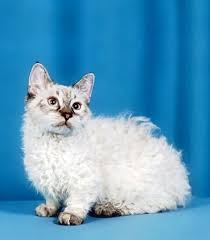
Lambkin
Conditions of detention
Lambkin cats thrive in indoor environments where they can be safe and comfortable. They enjoy interactive play and benefit from having toys and climbing structures to engage their playful and curious nature.
Useful Fact:
Lambkins are known for their social and friendly demeanor. They enjoy spending time with their human companions and get along well with other pets, making them excellent companions for families and individuals alike.
Nutrition and diet
Lambkins require a balanced diet rich in proteins, fats, and essential vitamins to maintain their energy levels and overall health. Premium quality cat food, whether wet or dry, is recommended. Fresh water should always be available. Treats can be given in moderation but should not make up more than 10% of their daily intake. Consult with a veterinarian to determine the best diet plan tailored to your Lambkin’s age, weight, and health condition.
Useful Fact: Lambkins, due to their small stature, can be prone to obesity if overfed, so portion control is crucial.
Health
Lambkins generally enjoy good health but can be prone to genetic conditions inherited from their parent breeds. Regular veterinary check-ups are essential to monitor for conditions such as hip dysplasia, heart issues, or dental problems. Vaccinations and parasite control should be kept up-to-date.
Useful Fact: Regular dental care, including brushing their teeth or providing dental treats, can help prevent periodontal disease, a common issue in cats.
Grooming and care
Lambkins have a unique coat that may be curly or wavy, requiring regular grooming to prevent matting and reduce shedding. A gentle brush designed for cats should be used several times a week. Routine nail trimming, ear cleaning, and occasional baths are also part of their grooming needs.
Useful Fact: Using a slicker brush can help manage their curly fur without causing discomfort or pulling.
Education and training
Lambkins are intelligent and can be trained to perform basic commands and use a litter box reliably. Positive reinforcement techniques, such as treats and praise, work best. Consistent training from a young age will result in a well-behaved and social cat.
Useful Fact: Lambkins can learn to walk on a leash, providing them with safe outdoor exploration opportunities.
Toys and entertainment
Lambkins are playful and enjoy a variety of toys that stimulate their hunting instincts and mental agility. Interactive toys, puzzle feeders, and cat trees can keep them entertained and active.
Useful Fact: Rotating their toys regularly can keep them engaged and prevent boredom.
Safety
Lambkins should be kept indoors to protect them from potential dangers such as traffic, predators, and diseases. Secure windows and balconies to prevent accidental falls.
Useful Fact: Microchipping your Lambkin can help recover them if they accidentally get lost.
Accessories
Providing Lambkins with comfortable bedding, scratching posts, and a designated litter box area is essential. High-quality carriers are necessary for safe transport to vet appointments or travel.
Useful Fact: Heated beds or pads can provide extra comfort for Lambkins, especially in colder climates.
Socialization
Lambkins are social cats that thrive on interaction with their human families and other pets. Early socialization helps them develop a friendly and confident demeanor.
Useful Fact: Inviting friends over and allowing your Lambkin to interact with different people can help them become more sociable and less anxious.
Travel and Transportation
Lambkins can adapt to travel if introduced gradually. A sturdy, well-ventilated carrier with familiar bedding can make trips less stressful. Ensure they have access to food, water, and bathroom breaks during long journeys.
Useful Fact: Familiarizing your Lambkin with car rides from a young age can reduce travel anxiety.
Behavior and psychology
Lambkins are known for their affectionate and gentle nature. Understanding their behavior helps in creating a positive environment. They communicate through body language and vocalizations, so paying attention to these cues is important.
Useful Fact: Providing vertical spaces like cat trees can help Lambkins feel secure and reduce stress.
Legal aspects
Check local regulations regarding pet ownership, including licensing, vaccinations, and microchipping. Some areas may have specific laws about keeping pets indoors or restrictions on certain breeds.
Useful Fact: Keeping a record of your Lambkin’s medical history, microchip information, and registration can be crucial in case of emergencies or if they get lost.


